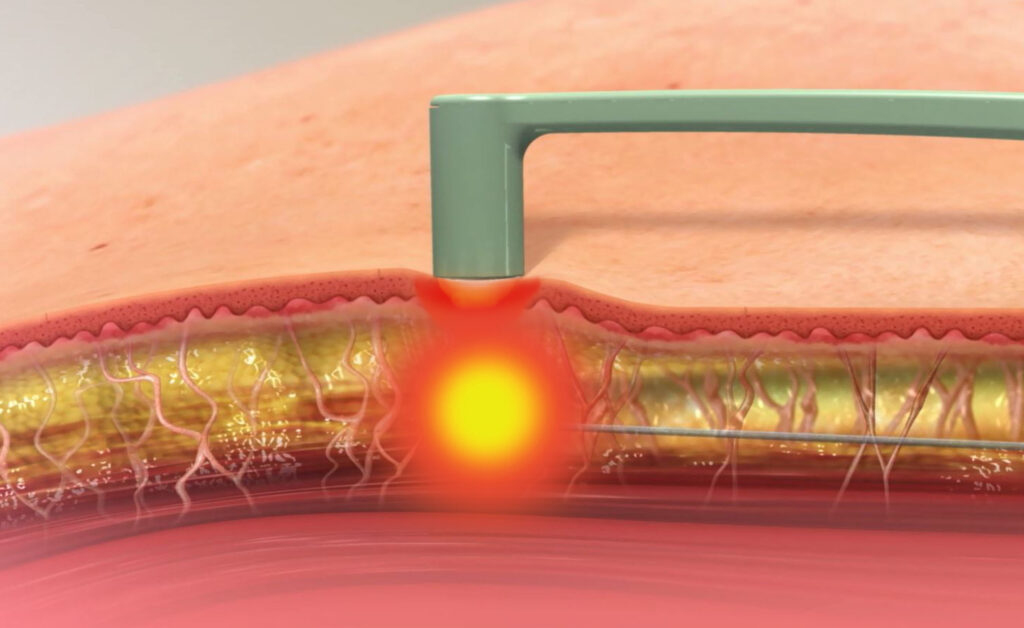Time, gravity, and the aging process are our faces’ worst enemies. As we age, the facial skin and tissues lose their tone and begin to sag. We also often lose the fat that provides a beautiful soft contour to the face. If your face has fallen prey to these changes, you are likely a good candidate for a cosmetic procedure like FaceTite or a facelift.
When it comes to cosmetic procedures, you want to make absolutely sure that you choose the right treatment to achieve your goals. Your plastic surgeon is your top resource for understanding the different results that different procedures will have for you. This introduction to FaceTite and facelifts will help inform your decision.
Dr. John Q. Cook has prepared this guide to help you understand the differences between facelift surgery and the FaceTite® procedure.
The Basics: What’s the Difference?
Each face ages differently. The goal of all facial rejuvenation procedures, surgical and non-surgical, should be the restoration of natural facial form. In order to accomplish this, the surgeon must make an accurate diagnosis. Where is the aging taking place? Is it mostly a loss of tone of the skin? Is it a loosening of deeper facial structures that control the contours of the cheek, jaw border, and neck? Is it a loss of facial fat? Is it a reduction in the thickness and quality of the skin?
A facelift is a powerful operation because it allows the surgeon to go beyond just addressing the tone of the skin; we can also tighten the deeper structures of the face. If the deeper structures are loose just tightening the skin may produce a weird and distorted result. Since a face lift allows us to address both the tone of the skin and the tone of the deeper structures the result is harmonious. It usually makes sense to combine facial fat transfer with the facelift operation, because most faces lose tone and volume as they age.

FaceTite has a distinct niche in facial rejuvenation. It works best for individuals who have a mild to moderate loss of tone of the skin along the jaw border and in the neck. This manifests itself as early jowls and loss of the crisp definition of the neck. As with a facelift, the FaceTite operation can be paired nicely with a fat transfer in order to restore missing facial volume. For people with advanced loosening of the skin and looseness of the deeper facial structures, the FaceTite procedure will be disappointing.
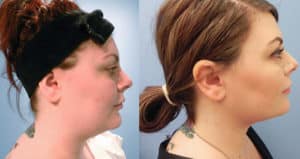
Only a facelift can reliably tighten deeper facial structures. There are some gadgets on the market that purport to tighten deeper structures via an external application of energy, but we would not recommend these for several reasons. First, they tend to melt some of the precious facial fat, which is the opposite of what you want with true facial rejuvenation. Second, they don’t work very well. Third, they sometimes produce scars at the deeper levels, so that when the disappointed patient decides to have a facelift and finally solve the problem of deeper tone, the plastic surgeon has to contend with scar tissue that makes correction difficult.
How does FaceTite® Work?
FaceTite is a device that allows the plastic surgeon to use radio frequency energy to tighten the skin.
The surgeon makes tiny incisions in the crease in front of the ear, behind the earlobe, and under the chin. She injects a numbing fluid under the skin and then delivers the energy via two probes, one under the skin and one on top of the skin. The probes are joined at a handpiece that is connected to the energy source and the computer that controls the system. Energy flows between the probes and brings the skin to a specific temperature, which causes tightening. This tightening process continues for at least 6 months.
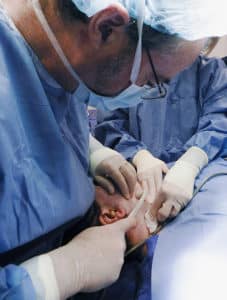
The progressive nature of the tightening makes FaceTite an ideal procedure for someone who doesn’t have a large amount of skin looseness and who wants a subtle result that gets better over time.
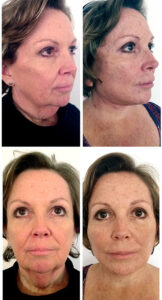
How does a Face Lift Work?
One common misconception about the facelift procedure is that it is just a matter of tightening the skin. The power of the facelift comes from a lifting of the deeper facial structures back to the position of youth. In other words, both skin and deeper structures are rejuvenated. Nothing short of a facelift will accomplish this.
Unlike FaceTite the facelift procedure requires incisions so that the surgeon can undermine the skin and reach the deeper facial structures. This is what puts some people off from a facelift since they are worried that the scars might show. With proper attention to artistic principles it is possible to hide the incisions along the contours of the ear and tuck the extensions into inconspicuous locations in the sideburn and along the hairline in the back of the ear. This is why it is so important to choose a plastic surgeon who is very experienced and who has an artistic sensibility.
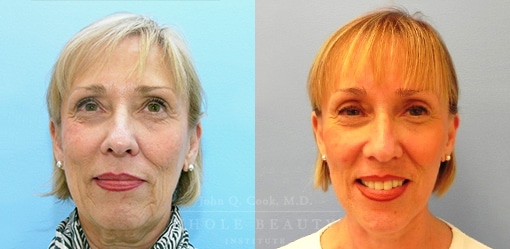
The Face Tite Experience
The two main advantages of FaceTite for the patient is the tiny incisions and the relatively short recovery period. In general patients with thinner faces will have the quickest recovery. As with any minor surgery, there will be swelling during the first few days and a variable degree of bruising. Most patients can return to normal light activity within a few days, but give yourself a few extra days if you will be at all self-conscious about minor bruising and swelling.
The treatment itself can be carried out under local anesthesia, with IV sedation, or even light general anesthesia depending on the surgeon and patient’s preference.
Although FaceTite is by far the most powerful of the minimally-invasive face tightening procedures, it is important to realize its limitations. It works best on faces that are relatively thin and that have a relatively mild degree of looseness in the jaw border and neck areas. The results can be expected to last for several years, considerably less than with a facelift.
There are two groups of patients that are ideal for FaceTite. The first group is patients with relatively early changes along the neck and jaw border who aren’t yet ready for a facelift. The second group is patients seeking what we call the “face lift refresher.” Several years after a combined facelift and fat transfer the patient will notice a mild loss of tone and a reduction in facial volume. A combination of FaceTite® and fat transfer under local anesthesia will restore a beautiful rejuvenation.
In short, if you don’t require too much of a change, want to avoid surgical incisions, and are looking for a quick recovery, FaceTite® may be a good choice for you.
The Face Lift Experience
The great advantage of a facelift is its power. Especially when combined with fat transfer, a facelift offers true 3-dimensional facial rejuvenation. The main disadvantage is a longer and more noticeable recovery. There will be stitches for one to two weeks around the ears and into the hairline. The longer your hair, the easier it is to hide them. For most patients, the bruising and swelling will last longer than with Face Tite. Most patients are pleasantly surprised by the relatively low level of discomfort after surgery.
The majority of plastic surgeons still carry out facelifts under general anesthesia or IV sedation, but there are some surgeons who have perfected local anesthesia techniques. Local anesthesia technique avoids the concerns associated with heavier types of anesthesia and provides an easier recovery for the patient.
The Whole Beauty® Approach to FaceTite® and Face Lift
Facial rejuvenation is our passion at the Whole Beauty® Institute. Dr. John Q. Cook, the leader of our team, has a set of principles that guide the activity of every team member:
We perform a careful analysis of each patient’s facial structure and how it has aged over time so that we provide a natural result that respects your unique identity.
For surgical procedures, we use local anesthesia whenever possible but we have deeper anesthesia if the patient prefers. We carry out the majority of our facelifts and almost all of our Face Tite procedures under a local anesthesia technique.
Whenever possible a single procedure should restore facial tone, volume, and youthful skin appearance. We call this 3D rejuvenation.
We believe in a team approach that prepares your face for surgery and that enhances the long-term result by maintaining your beautiful appearance.
We combine products and treatments with surgery for added power. The Whole Beauty Team: Here to Guide You Patients who seek facial aesthetic surgery trust their surgeon to recommend the right treatment and to expertly administer it. At The Whole Beauty® Institute, Dr. Cook and his team place their years of experience and dedication to premier patient service and care at your disposal. Because of this, you can feel completely confident in your decision and your procedure. If you are interested in a facelift, FaceTite, or other facial cosmetic procedure, schedule your consultation with Dr. John Q. Cook today: contact The Whole Beauty Institute at 312-751-2112.



